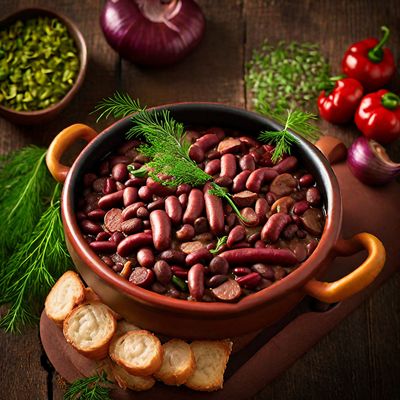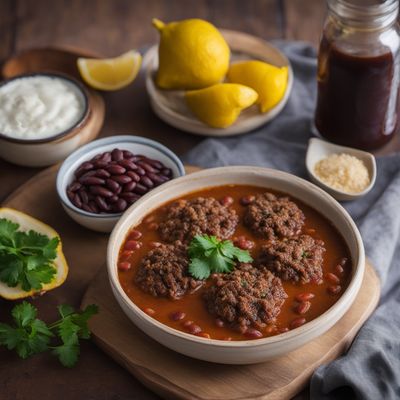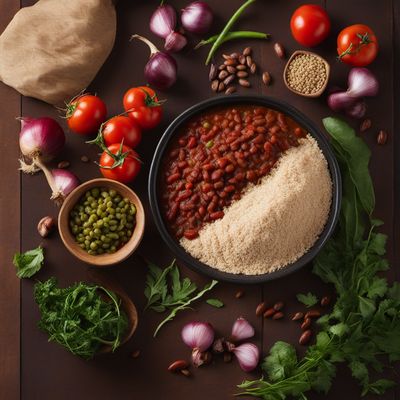
Ingredient
Kidney bean (dry seeds)
The Mighty Red Bean
Kidney beans are medium-sized, kidney-shaped legumes with a firm texture and a rich, earthy flavor. They have a smooth, shiny skin and come in a vibrant red color. When cooked, they have a creamy interior and hold their shape well.
Origins and history
Kidney beans have been cultivated for thousands of years and are believed to have originated in Peru. They have a long history of culinary use in Latin American, Caribbean, and Indian cuisines. In many cultures, kidney beans are considered a staple food due to their high nutritional value and versatility in cooking.
Nutritional information
Kidney beans are a nutrient-dense ingredient, rich in protein, dietary fiber, folate, iron, and potassium. They are also low in fat and cholesterol, making them a healthy addition to a balanced diet.
Allergens
Kidney beans may cause allergic reactions in some individuals, particularly those with legume allergies. It is advisable to exercise caution and consult a healthcare professional if you have any known allergies or sensitivities.
How to select
When selecting kidney beans, look for dry seeds that are uniform in size, with a vibrant red color and a smooth, unblemished skin. Avoid beans that are discolored, shriveled, or have signs of insect damage. Opt for reputable brands or sources to ensure quality and freshness.
Storage recommendations
To maintain the freshness and quality of kidney beans, store them in an airtight container in a cool, dry place. Avoid exposure to moisture, heat, or direct sunlight, as these can lead to spoilage or loss of flavor. Properly stored kidney beans can last for up to a year.
How to produce
Kidney beans can be grown in home gardens or small-scale farms. They require well-drained soil, ample sunlight, and regular watering. It is recommended to start with high-quality seeds and follow proper planting and care instructions for optimal growth and yield.
Preparation tips
Before cooking kidney beans, it is essential to soak them overnight or for at least 8 hours to soften their texture and reduce cooking time. They can be boiled, simmered, or pressure-cooked until tender. Kidney beans are commonly used in soups, stews, chili, salads, and vegetarian dishes. They pair well with spices, herbs, tomatoes, onions, and garlic, adding depth and heartiness to various recipes.
Substitutions
Cannellini beans, pinto beans, or black beans can be used as substitutes for kidney beans in most recipes. However, keep in mind that the flavor and texture may vary slightly.
Culinary uses
Kidney beans are widely used in dishes such as chili con carne, rajma (Indian kidney bean curry), feijoada (Brazilian black bean stew), and red beans and rice (a popular Creole dish). They are also a common ingredient in salads, dips, and vegetarian burgers.
Availability
Kidney beans are commonly available in North and South America, Europe, and Asia. They are cultivated in countries such as the United States, Mexico, India, Brazil, China, and Italy.
More ingredients from this category
Recipes using Kidney bean (dry seeds) » Browse all

Namibian-style Fave e Cicoria
Savory Namibian Greens and Bean Stew

Maneštra od bobići (Croatian Bean Stew)
Hearty Croatian Bean Stew: A Taste of Tradition

Kazakh-style Grah with Pickled Cabbage or Sauerkraut
Hearty Kazakh Grah: A Tangy Twist with Pickled Cabbage

Haitian Rice and Beans
Savory Delights: A Taste of Haiti with Diri ak Pwa

Feijoada - Russian Style
Hearty Russian Feijoada: A Delicious Twist on a Brazilian Classic

Dikgobe Stew
Savory African Bean Stew: Dikgobe Delight

Chili Cheese Burger
Spicy Delight: The Ultimate Chili Cheese Burger

Emirati-style Slopper
Spiced Beef and Bean Slopper with Emirati Flair

Githeri with a Twist
Spiced Kenyan Githeri: A Hearty Delight

Tongan-style Tuna, Bean, and Onion Salad
Tropical Tuna Delight: Tongan-Inspired Salad with Beans and Onions

Ugandan Kikomando with Spiced Beans and Chapati
Savory Ugandan Street Food Delight: Kikomando

Haipai-style Moro de Habichuelas
Shanghai Fusion: Haipai-inspired Moro de Habichuelas